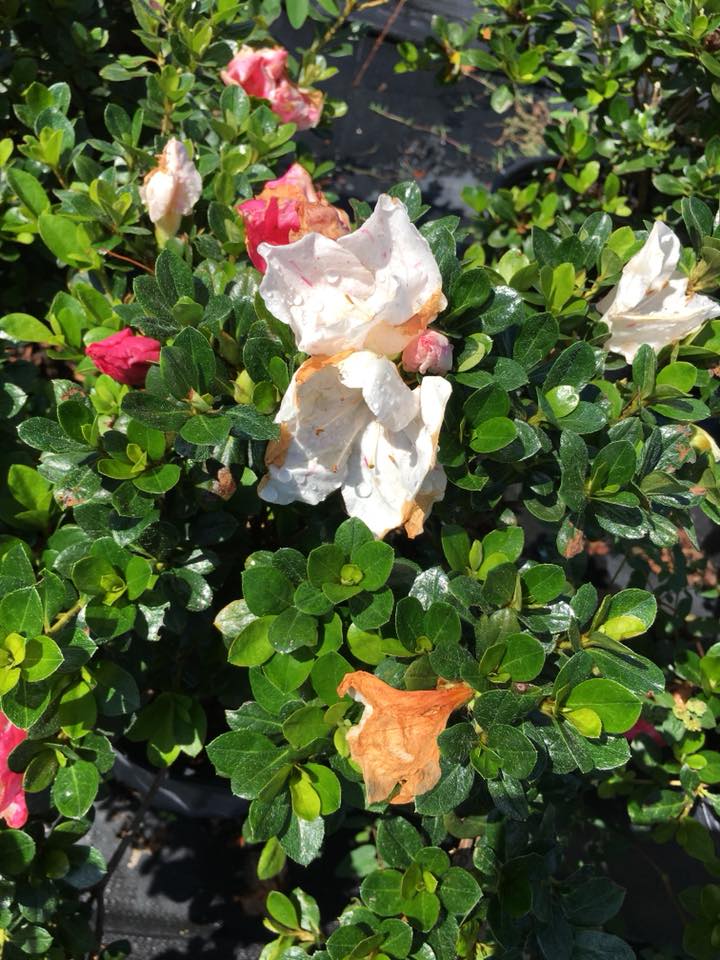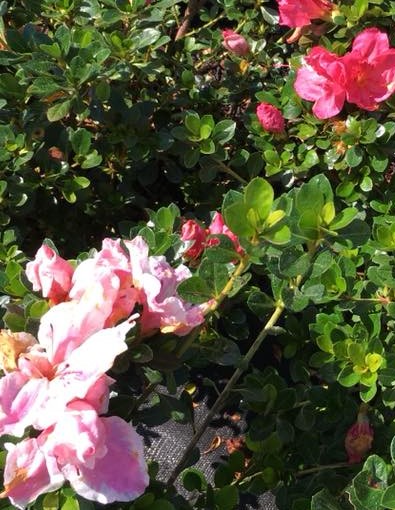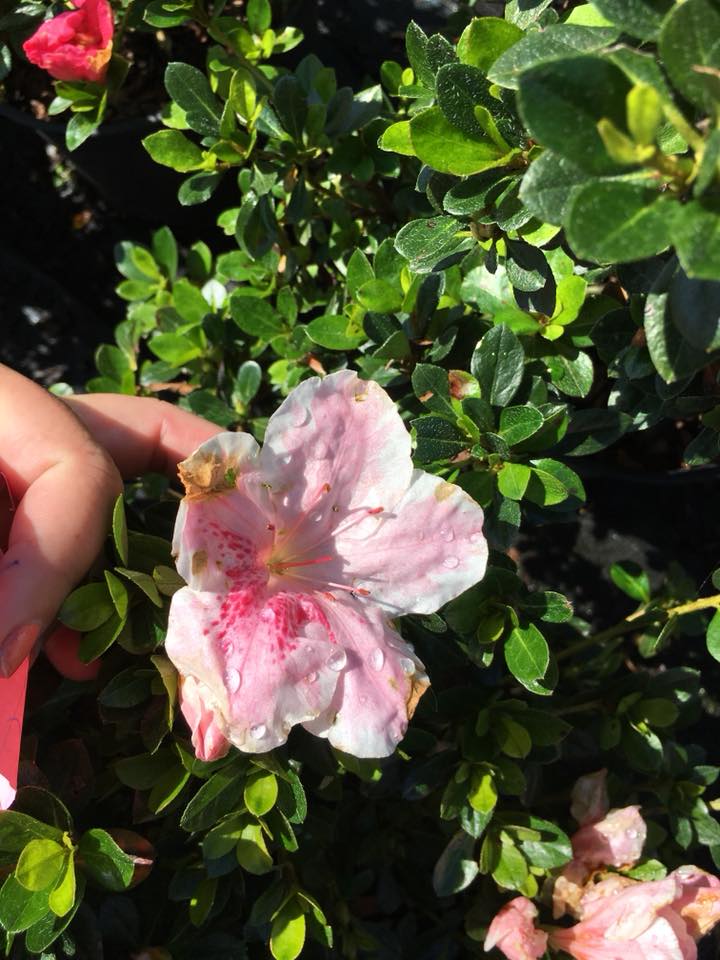S & J Nursery’s Guide to Growing
Conversation Piece Azalea
for Northeast Florida Landscapes
( Rhododendron Indica / Hybrida ‘ Conversation Piece ‘ )
Conversation Piece Azalea Origins:
– Most Azaleas found in modern nursery sites are evergreen members of the Rhododendron family and are native to Asia, but North Florida is the native home to a few deciduous Azaleas with somewhat gently fragrant blossoms. Conversation Piece is a hybrid Azalea bred from the results of a lifetime love affair with these pretty plants.
-Robert Gartrell introduced a number of excellent azaleas called the ‘Robin Hill’ Azaleas named for his country home “Robin Hill”. Among that collection of compact Azaleas is one of my absolute all time favorite introductions the ‘Conversation Piece’. It has outstanding hardiness, compact lush foliage and large blooms that are simply amazing. Pictures just can not do these plants justice. Having them planted in the landscape is surely the conversation starter they were named for.
Preferred Exposure for Azalea Conversation Piece:
– Azaleas including the Conversation Piece can be planted in partial sun or shaded conditions. Full sun in the morning followed by shade in the afternoon or late evening is ideal as well as filtered light under taller trees that may get some direct sun during parts of the day here in our North Florida Jacksonville | St. Augustine area landscape.
Conversation Piece Azalea Foliage:
– Small evergreen foliage is a deep dark green color and looks its best when trimmed or pinched back each year following the spring bloom. What I love about Conversation Piece aside from its unique multi colored blooms is how easy these plants are to keep nice and fully foliated. They don’t seem to struggle to keep nice foliage as much as other hybrids bred for their blooms tend to.
Soil Preference / Salt tolerance:
– Conversation Piece Azalea’s will prefer fertilize, well drained soils that are acidic ( from 4.5 – 6.0 on the PH scale ) Iron chlorosis will become problematic when planted in Alkaline soils.
– Avoid planting in heavy wet clay soils as root rot will cause the foliage to yellow and wilt or the plant to completely die out after periods of prolonged heavy rains.
– Will not tolerate wet soils even for short periods.
– While we do not recommend Azaleas for use in poorly drained areas that will stay wet during our heavy rain season. If you just must plant Azaleas into a consistently moist area raise the area into a berm 8-12 inches above the existing soil level with compost to help its roots get up out of the water after a rain. We have seen long term success with this method in customers homes.
– Azalea shrubs have a low salt tolerance and should be avoided for coastal
plantings.
Size Variance of Conversation Piece Azaleas:
– Conversation Piece Azalea can reach sizes of 2-3 feet High | 2-3 feet Wide and are easily maintained at the lowest of its range in the landscape with just a yearly pruning.
Growth Habit of the Conversation Piece Azalea:
– Conversation Piece shrubs have a mounding or rounded habit.
Growth Rate for Conversation Piece Azaelas:
– Slow growing shrub is easily maintained with minimal pruning. Expect 3-6 inches in height in a growing season until plants reach maturity.
Blooms on the Conversation Piece Azalea:
– Blooms of the Conversation Piece Azalea are a wonder in and of themselves. They emerge in one of three color patterns. White with bright hot pink streaking, all over hot pink or soft pink and white, all at the same time on the same plant giving your Azalea you a multi colored display rivaled by none. They are truly unique and beautiful. Blooms are rather large for such a small plant and reach 3-4 ” wide with a single layer of petals with a slight ruffle to the edges.
– Conversation Piece is an extremely long season blooming Azalea and the heavy spring bloom is followed by a series of blooming, setting buds and rebloom again throughout the summer and into fall in the North Florida | St. Augustine | Jacksonville area gardens. All that blooming requires a fair amount of nutrition so be sure to plant them into amended soil and add a bit of compost to the garden area each spring.
Water Requirements for Conversation Piece Azaleas in Northeast Florida Landscapes:
– Moderate to high water needs, especially in sandy soil landscapes or more sun locations. Azaleas tend to form a shallow root system and should be planted into landscapes where supplemental irrigation is possible during prolonged periods of drought. If you have sandy soils and non irrigated spaces, amending the soil with compost when planting helps the soil hold onto the water that it gets and gives the plant longer to get to that water source. Water at least once to twice weekly in times with little to no rainfall to keep them looking their best.
– Will not tolerate wet and water logged soils even for short periods.
Butterfly or Bird Attracting:
– Attracts butterflies.
Best Uses For Conversation Piece Azaleas:
– Azaleas are among the most common landscape shrubs for the North Florida area. They can be used as foundation plantings, mass plantings in large beds, and used as foundation accents or focal points.
– Azaleas are perfect when massed in large groupings as under plantings for the edges of natural areas or larger native Oaks and Maples.
Care of S & J Nursery’s North Florida | Jacksonville | St. Augustine Azalea
Shrubs:
– Azaleas should be pruned each year after flowering to maintain the best foliage and shape possible. They may be trimmed at any time during the summer months but remember not to trim to late in the season or you may be cutting off next years blooms! A good rule of thumb for the North Florida are is not to prune in the fall, wait until they have bloomed the following spring and trim once after spring and once in the summer.
– Azalea shrubs will need acid plant food made for Azaleas for best results.
– Azalea shrubs can be planted in the North Florida | Jacksonville | St. Augustine area at any time during the year. In normal and well draining soils dig the hole as deep as the root ball and two to three times as wide. Plant the top of the root ball level or slightly higher than the surrounding soils.
-Avoid planting in poorly drained soils.
– Water every day during the establishment period. For most 3 gallon size shrubs in the North Florida landscape in average soil, that is neither heavy clay that holds water or really sandy that will take 2-3 weeks of daily watering to ensure that your newly planted shrub will begin to put out new roots and grow into its new home happily. After the first few weeks begin tapering back your watering to every other day then every third day and so on until your newly planted items are flourishing without your assistance.
– Azaleas will need supplemental irrigation during times of excessive heat or drought.
– IMPORTANT: If planting shrubs in heavy clay soils that hold allot of water after a rain or irrigating, remember to check the soil for moisture by sticking your fingers into the soil near the root ball of the newly planted shrub down to 2-3 inches. If it remains wet from the previous watering wait for the top 2-3 inches to dry out before watering again.
– IMPORTANT: When planting shrubs into poor sandy soils be sure to amend the planting hole by mixing compost or cow manure etc. with the native soil that will go back in the hole around the new plants root ball when installing your shrub material, this will not only give your new shrubs good soil to grow its new roots into but help it hold water.
– When planting Azalea shrubs from containers be sure to loosen the roots as much as possible pulling loose roots away from the root ball before installing your new plants, if the roots are to tight to easily loosen with your hands use a knife to cut a few slits into the root ball being careful to go all
the way from the top to the bottom and making the cut at least an inch deep. This will ensure that your plant will immediately begin to form new roots into its new surrounding soil.
– Mulch newly planted shrubs whenever possible. Azaleas will benefit from a 2-3 inch layer of Pine bark or Pine Straw.
– Fertilize each spring with a mixture of Milorganite and a good acid fertilizer made specifically for acid plants like azaleas camellias and gardenias. Be sure when fertilizing to sprinkle the fertilizer around the mulch circle underneath the foliage of the shrubs.




